Even fish in an aquarium want to be fed appropriately! Everyone knows the cliché of the XXL flake food can, which sits on the cover of the tank and is handled several times a day. Which takes us right to the nitty-gritty! Aquarium fish need to be:
- fed appropriate to their species
- fed food small or big enough for their mouths
- fed economically
- be fed varied food
If you, as an aquarium owner, follow these four principles, you will be rewarded by the animal inhabitants with a long and healthy life. We will now take a closer look at these subitems.
Feeding types
What does that mean anyway? To stick to the example of a flake food can: most species of fish indeed will eat flake food, but a species-appropriate diet means that the diet is adapted to the natural feeding behavior and the choice of food. First of all, a distinction is made here between different diet types. Carnivores eat meat, herbivores on the other hand mainly eat vegetables. Omnivore species eat everything. These dietary habits should be considered.
Carnivores
Carnovorous fish require a high-protein diet in the shape of live-, frost- or dry food. Carcasses, in other word: carrion, as food falls under this type of diet as well. Predatory species usually eat carnivorous. In the aquarium, for example, these include most of the cichlids.
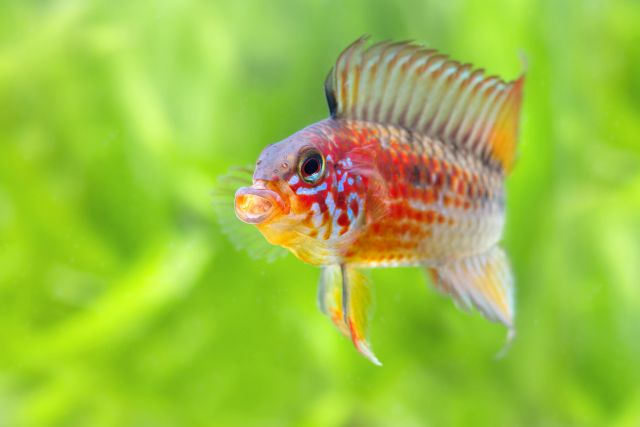
Copyright by Chris Lukhaup.
Herbivores
Herbivorous fish species prefer a vegan diet. Usually animals on this type of feed have a longer digestive tract. Many species of catfish primarily eat vegetable food and, above all, graze the biofilms off of all hard surfaces. This growth consists of microorganisms such as algae, bacteria and fungi.
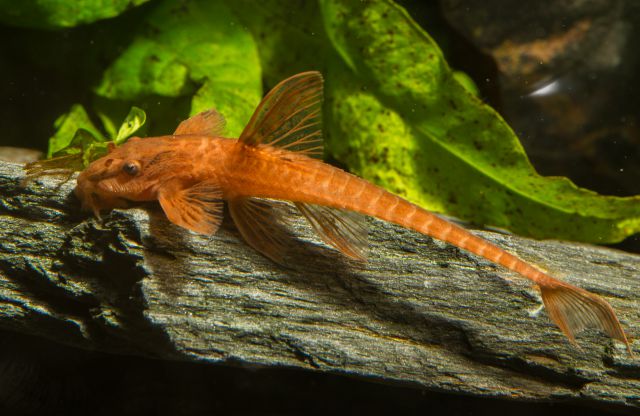
Dried leaves such as oak leaves, but also fresh food like blanched plant leaves (e.g. stinging nettle) or veggies (sliced cucumber, zucchini, etc.)are gladly accepted as food. Since especially some catfish species are dependent on an increased fibre content in their diet, countless manufacturers offer special feeding tabs, containing high amounts of veggies and sometimes even some wood, to meet the need for fiber.
Omnivores
Omnivores eat both, plant- AND meat-based food. They are thus quite flexible in their food choices. For example, we humans are arguably among the omnivorous creatures, too. Well-known aquarium fish that fall in this category are most of the viviparous species like the popular guppy. Nonetheless, omnivores may still have a certain focus in their diet, either on the carnivorous or herbivorous side. Omnivorous fish are especially happy about a varied diet.

Copyright by Chris Lukhaup.
Food specialists
Food specialists include living beings that can consume only a certain amount of food. In terms of nutrition, such animals therefore require special attention. Typical candidates in aquaristics are, for example, puffer fish species, which necessarily need snails as the main food source. If snails are unavailable as food, these animals can get problems with the tooth growth and eventually die.
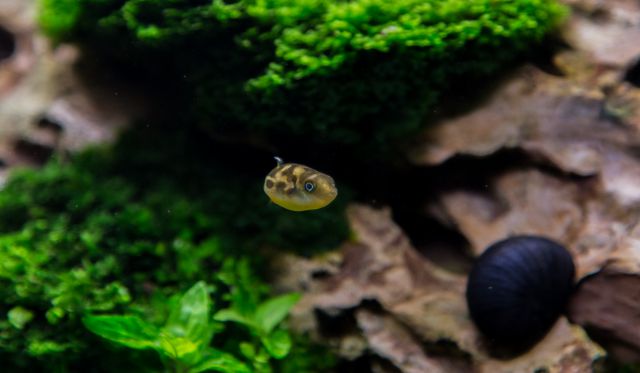
Species-appropriate feeding
Species-appropriate feeding now means, above all, that consideration is given to the respective diet types and that the animals in the aquarium are offered appropriate food. If you keep fish and invertebrates in the aquarium, who all belong to different nutritional types, the range of feeding should be adapted and each group of inhabitants should be fed individually, appropriate to its species.
Bite-sized food
This means that the food should be adapted to both the size and the shape of the fish muzzle. Small nano fish obviously can not take large chunks of food or ingest them. Appropriatly small food as granules or powder is more suitable. There are also small frost- and live foods such as freshly hatched artemia nauplii. On the other hand, larger animals should also get appropriate food. A stately discus fish can not absorb tiny food particles such as powders.
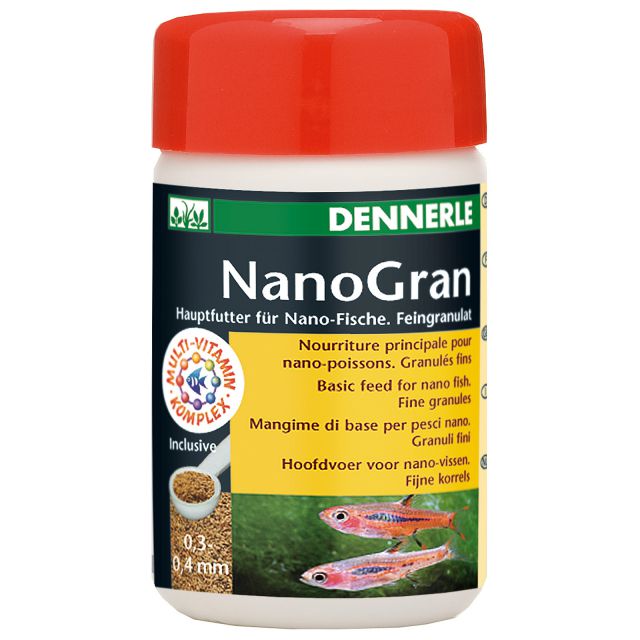
Dennerle Nano Gran is a special granulate for small fish.
With regard to the mouth shape, a distinction is always made between:
- a projecting mouth. Here, the food is absorbed primarily on the water surface. Swimming foods like flakes and buoyant granules are advisable..
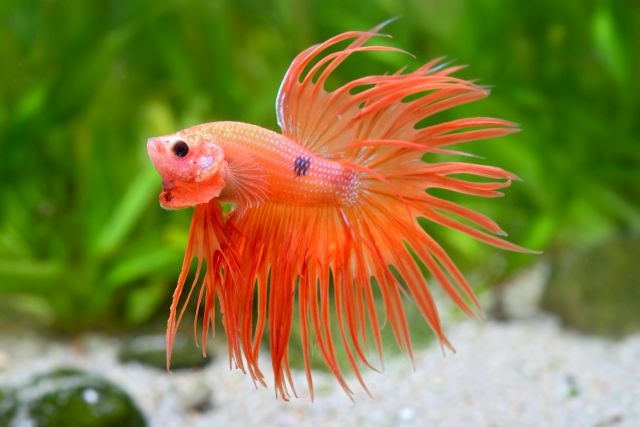
Fighting fish habe a projecting mouth. Copyright by Chris Lukhaup.
- inferior. The food intake happens on the ground. For these fish, sinking food and nourishment given as tablets are very suitable.
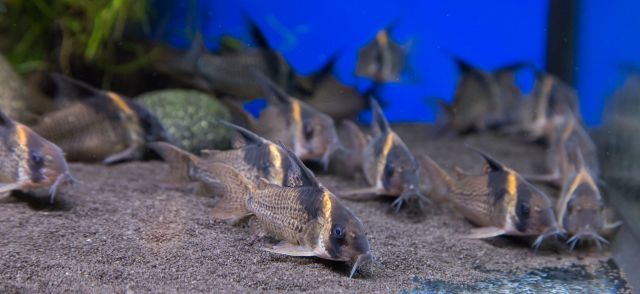
Cories have an inferior mouth.
- terminal mouth. Placed in a middle position, the animals mostly feed in free water. Food that sinks slowly or is distributed by the flow, accommodates this type of diet.
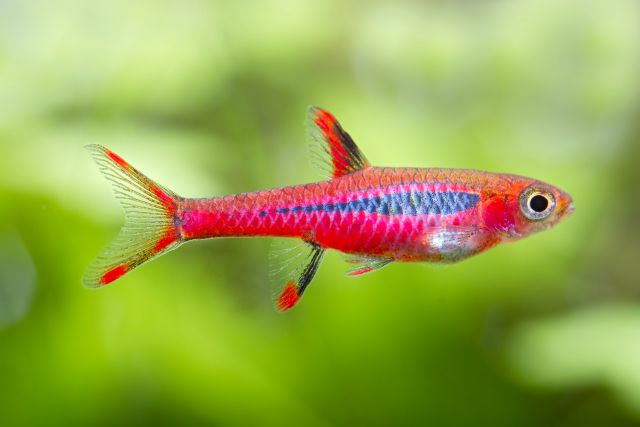
This Boraras has a terminal mouth. Copyright by Chris Lukhaup.
Economical feeding
Fish should only be fed as much as they can eat in a few minutes. Leftovers increase the water load and should better be removed. A good help for this is a cleaning troop of invertebrates such as snails and shrimp for the aquarium, which are excellent scavengers. In addition, it can’t hurt to in a fasting day or two during the week. In the aquarium, however, sufficient food is usually still available in the form of microorganisms and algic growth, from which the animals can feed.
Varied feeding
To feed in variety means to vary often and regularly between different types and shapes of feed. Instead of just feeding flakes all the time, you can offer them tabs or granulate every once in a while. The aforementioned XXL flake food can makes little sense here, since the overabundance of food encourages an unbalanced diet. Feed types in smaller packages make much more sense.
If dry food is used almost exclusively, the fish will be happy with an addition of frozen or live food once or twice a week. Herbivores also need proteins from time to time and are therefore allowed to occasionally get meaty food. Omnivores should switch more often between vegetable and meat food.